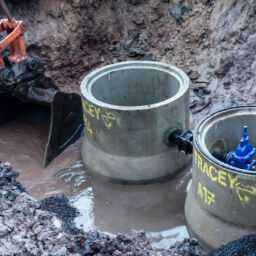Design And Construction Standards For End Suction Pumps
An end suction pump complete with isolation valves, vibration isolators, a suction strainer, long-radius ell and reducer at inlet, spring-supported inertia block, drain pan, and other amenities normally associated with hydronic service is a single stage pump with only one impeller. Isolation valves, if required, are typically butterfly, gate, plug, or ball valves, depending upon line size and duty requirements. The weight of the piping to the vibration isolation fittings is normally supported by overhead suspension.
Strainer
A strainer is required to collect debris in the system. The strainer includes a provision for blowdown, which will allow loose debris to be flushed from the strainer when the pump inlet valve is closed and backflow from the discharge of the pump through the flush valve occurs. The flush valve is typically a 2-in. diameter or larger ball valve installed complete with a piping “tail piece” routed to a floor drain for spill containment. The screen in the strainer should be specifically selected for use in a water system. If a strainer is used in a condenser water system, it should have openings in it larger than that associated with chilled water service. Often the strainer in a cooling tower basis suffices for this purpose, and the one in the piping is not required. Since strainers can be purchased integral to air separators and pump suction diffusers, drawings and specifications should be carefully coordinated to ensure that only one strainer is installed in a chilled or hot water hydronic system.
Pump Inlet
An end suction pump requires either a straight length of pipe into the pump suction or a suction diffuser. If a straight pipe section feeds the pump, the straight pipe section should be at least three pipe diameters long, be fed via a long radius elbow, and incorporate a reducer fitting at the pump inlet. All of these promote uniform flow into the pump impeller. Depending upon the weight associated with the pump inlet piping from the vibration isolator downward, a stanchion pipe support may be required. If it is required and no spring-isolated inertia pad is used, the stanchion should be supported from the pump base. Normally, with small pumps, a spring-isolation inertia pad is not required.
Pump Discharge
It is common practice and necessary in hydronic systems to use an increaser at the pump outlet. This is because of a noise consideration associated with high-velocity flow at pump discharge. A check valve is required in a pump discharge when pumps are in parallel or when water must be retained in a system to keep it full, such as for a cooling tower mounted at rooftop level above a mechanical equipment room.
Pressure Ports
Provisions should be made with all pumps for measuring differential pressures so that pump flow can be determined from the manufacturer’s pump curves. The arrangement allows a single gauge to be used for pressure measurements. The use of Pete’s plugs is suggested in situations where pressures are not excessive (<200 psig) and operating temperatures will permit it. Other ports and taps are sometimes available in the pump suction and discharge flanges of the pump. When they exist, they should be utilized for pressure measurement across the pumps, as the manufacturer has probably utilized measurements made in these locations for generation of pump curves.
Piping Isolation
Piping vibration isolation fittings, normally consisting of a rubber bellows and sometimes mounted in a stainless-steel braided wire jacket where service limits require it, are available from a number of vendors. One inexpensive way to allow for piping vibration isolation and noise containment where the amplitude of the vibration is small is via the use of grooved couplings, one installed at the pump and another one at the top of the discharge pump riser where it goes into a manifold or makes a change in direction. Use of grooved couplings, however, is also constrained by fluid service limitations and the amplitude of the vibration anticipated.
Other Considerations
The pump base has a drain pan for leakage-containment purposes. Some manufacturers include a pan in the pump base, and when this exists, the pan should be omitted from the detail. Several low-point drain valves are indicated. These should include hose bibb connections, and each should be capped when not in use to protect the threads on it. Care should be given regarding the location of the hose bibb, so that connections to each with a garden hose is always both possible and convenient. The coupling guard should extend over the pump and motor shafts so as to prevent any form of entanglement with the rotating shafts, as is required by the Occupational Safety and Health Administration ( https://www.osha.gov/ ).
garden hose
#Design #Construction #Standards #Suction #Pumps
Will be pleased to have you visit my pages on social networking .
Facebook page here.
Twitter account is here.
Linkedin account here
Post byBedewy for info askme VISIT GAHZLY



